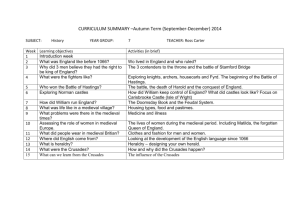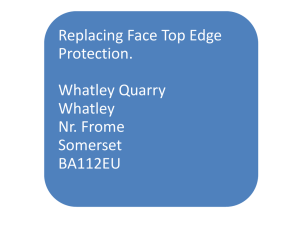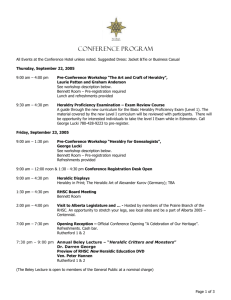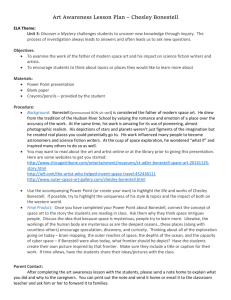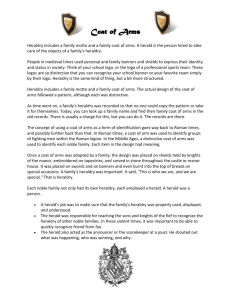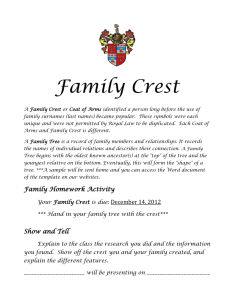Medieval Heraldry
advertisement
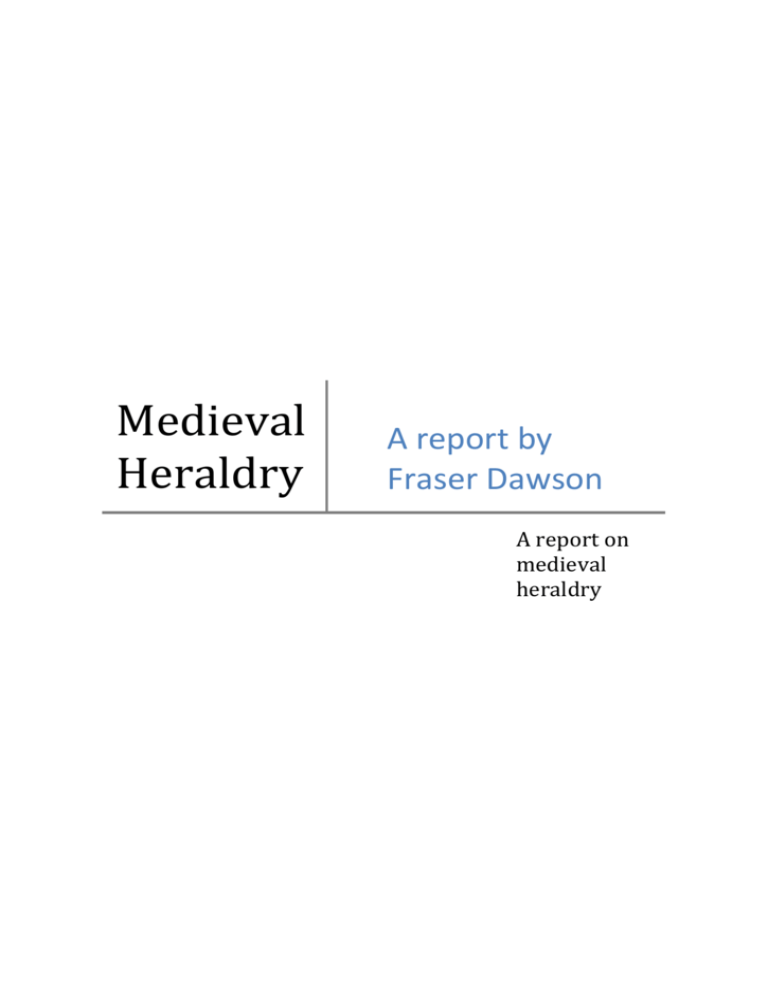
Medieval
Heraldry
A report by
Fraser Dawson
A report on
medieval
heraldry
Medieval Heraldry
The Background of Heraldry
Heraldry began in the early middle Ages. Before heraldry, nobles could not
differentiate between different nobles, besides conversing with each other. This is
virtually impossible in a battle, and so the system of decorating one’s shield came
into practice. A system was devised to grant and record new heraldic symbols. Soon
all nobles in Europe had a shield of heraldry to broadcast their family heritage. There
were certain rules, however. Only a king could use purple, and nobles were allowed
to use green, blue, red, black, gold and yellow for their backgrounds, and could have
the same colours but with white for any decoration of their heraldic shield they
might like. The first, second, third and fourth sons would all receive a slightly
different symbol. As a first son would receive no additional pieces, but a second son
would have a sun included in the design. Furthermore, a third son would receive a
moon, and a fourth son, fifth son, sixth son, et cetera, would have a star. It is
suggested that this is the origins of the word ‘son’ and the
cause of the similarities between the aforementioned word
and ‘sun’. For women it was a completely different story
however; they would hold a large rhombus, approximately
eighty centimetres from tip to base. This would have the
heraldic crest of the family, and so show from which family
this lady came. If a noble came from the line of two
outstanding families, they might decide to conjoin the two
crests and create a double-crest. This crest might then be
expanded further, and was permitted to have an infinite Fig. 1: The Grenville Armorial
at Stowe’s incredible 719
number of single crests. One crest is recorded as having 719
different crests
different families’ crests [Fig. 1].
Coats of arms often had many additional decorations, including supporters on the
side of the shield. For example, the Australian crest’s supporters are a kangaroo and
an emu. These two can represent different things. Using the Australian coat of arms
as an example again, we see that neither the kangaroo nor the emu have the ability
to walk backwards. This implies that Australia will never move backwards, exactly
like its supporters. Often, there is a motto beneath the shield itself. Taking the
Australian heraldic crest for a third time as an example, the motto is simply
‘Australia’. Whilst the Australian coat of arms is not an overly accurate
representation of medieval heraldry, simply because it is not owned by a family, but
a country, it is similar enough to be an appropriate example. Shields often have a
background, although it is not always completely opaque. It is mostly a filler, to fill
the spaces between the supporters, motto and shield itself. It should be noted that
on shields and rhombuses, only the shield is shown, not the supporters, background
or motto. As such, all details except the shield itself are optional; in fact, in England,
not all were licensed supporters. One had to be of high social status to be allocated
supporters. Heraldic symbols were still widely in use well into the renaissance, and
some heraldry-granters still exist to this day.
By Fraser Dawson
Page 1
Medieval Heraldry
Design of a modern-day equivalent to medieval heraldry
[Fig. 2] The design of the Dawson family crest
The Reasoning behind the Colours
Some of the colours chosen for this piece were chosen purely due to aesthetic
choices, but most were chosen to be representative of features of the family’s
background. As is visible, one can see a green and black background. The black is
representing the room for expansion, and also how many more paths there are for
the family to follow. The green is displaying the family’s passion for gardening, even
if not all members do not enjoy said subject. Any symbols of position in family [1 st
son, 2nd son, etc.] would be red. This is one of the few colours chosen purely due to
By Fraser Dawson
Page 2
Medieval Heraldry
aesthetic taste. The eagle, the centre of the crest, is blue. This, and, admittedly, the
eagle itself, represent that the sky is the limit.
The Reasoning behind the Symbols
The symbols in this crest represent a number of things. Once more, we shall begin
with the background. In this case, the designer has chosen a cross on a base of black
for his background. Obviously, one cannot go deeply into the shape of the shield
itself, seeing as that was typical of all medieval heraldry. The cross is not a symbol in
itself, merely a decorative item. It does show, however, that the designer of this
shield had impeccable taste. Any symbols of familiar positions [1 st son, 2nd son, etc.]
are represented by four of the required symbols, one in each corner. This shows that
any person can be any matter of things they want to be, metaphorically providing
four different routes for the mindset and personality of the person to take. The eagle
represents many things. For one thing, it represents intelligence. The designer
almost went for an owl, but decided that not to be majestic enough to be chosen. In
another way, it represents that the sky is the limit. Anyone can become what ever
they want to be is the message conveyed by this particular aspect of the eagle. It
also resembles strength. Not just physical strength, but mental strength, including
free will, not falling for peer pressure, making wise decisions, etc. The eagle
represents also beauty, a majesty that conveys itself onto all that view it. All of this
combines to form the mighty symbol of the blue eagle. The eagle combines with the
other symbols to create a plethora of different symbols, combining to create an
extensive biography of the Dawson family.
If the Dawson family crest were to have supporters, a motto and a background, then
the supporters would be two owls, the motto would be sit potentia[there is a power
{it was meant to be ‘power is power’ but google translate wouldn’t work}] and the
background would be books flying from the centre of the crest. As one can tell,
knowledge is a major part of the Dawson family.
Where the Crest is Displayed
The Dawson family crest is displayed in a position not far from the television, this
being a spot in which it is easily visible to all that enter the house. The designer
chose this location because of its prominence in the room. This, crossed with vibrant
colours used in the design, combined to give the crest a vital part in the room’s
decoration.
Construction of the Tangible Object
This crest was particularly easy to construct, seeing as it was made completely from
a medium designed exactly for easy construction and destruction of models and
structures. Even so, the designer was stuck for quite a long time attempting to
decide the medium through which the crest was to be displayed. Eventually though,
the constructor decided on a medium and set to work.
By Fraser Dawson
Page 3
Medieval Heraldry
Step 1:
To begin with, the designer collected the tubs of
building material from the location of storage to a
suitable construction location. This did not require
a lot of thought, seeing as the designer enjoys
working with this medium, and would go as far as
to say he is an expert in the field.
[Fig. 3] The designer at work in an early
stage of construction
Step 2:
The next step was to construct the background of the shield [Fig. 3]. The artist chose
to construct this with a double thickness, as opposed to a single thickness, seeing as
this would increase strength. The artist also chose to make the horizontal bar of
green 4 sizes thick, as opposed to the usual 3, because he believed this to be more
equal to the double thickness of the vertical bar. The designer also left out two blue
bars, protruding from the background, to provide as support to the main subject.
Step 3:
This step was to be the final parts in the
construction of the shield itself: the eagle and stand.
The artist crested the eagle to be again double thick,
and this creates a similarity throughout the crest.
The eagle’s legs were added as almost an
afterthought, long after the eagle was completed.
The stand was red, the only time in this piece the
colour was used, but if the shield had been for a 2nd,
o [Fig. 4] The constructor constructing the
3rd or 4th son, however, there would have been
blue eagle
o
corresponding shapes in the four corners. These,
however, would have been only one block thick, implying the degrading level of
importance involved with each iteration of symbols.
Step 4:
The fourth and final step was to place the crest in its proper
location. The constructor pondered over this, until finally coming
to the conclusion that next to the television would be the best
place for the lego model.
References
Wikipedia Heraldry http://en.wikipedia.org/wiki/Heraldry
[fig.5] The crest in its
proper place
The author of this work would like to note that all images [except images 1 and 2] are reversed. This is due to a nuance in the
photography software, and the author advises that to achieve the correct image [except for image 1 and image 2] a mirror
should be used. Under no circumstance should any of the images [except image 1 and image 2] be considered 100% accurate.
All images [apart from image 1] were produced after the completion of the original and final model. This is due to a lack of
photographic tools and planning knowledge during construction. Any claims that any of these images [except image 1 and
image 2] are non-fabricated and/or authentic in any way should be considered fraudulent.
By Fraser Dawson
Page 4
